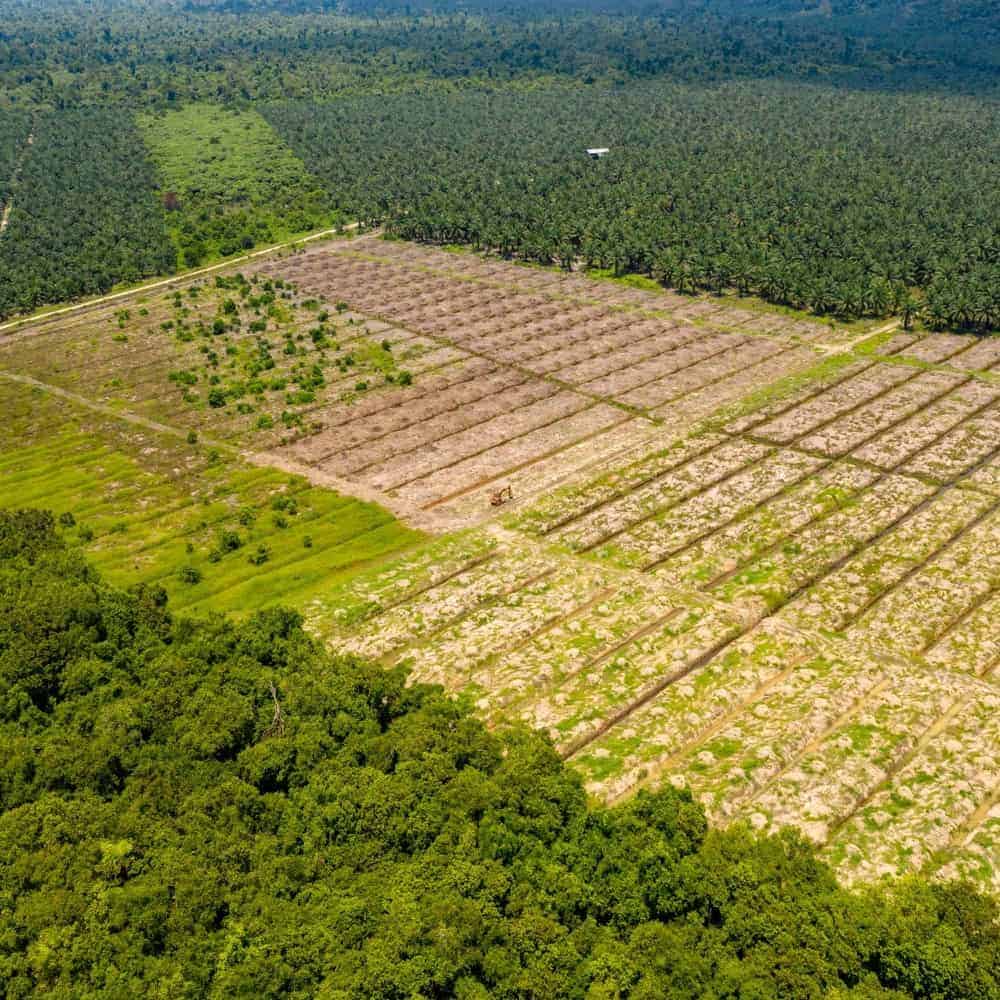Deforestation and solutions; including reforestation |
Deforestation of our planet, for centuries, has led to issues such as - loss of wildlife habitat; as well as land, water, and air pollution. Clearing forests results in greenhouse gas emissions (GHGs) from the practice of deforestation itself (leading to an unmitigated increase in global warming). Deforestation is also responsible for the loss of trees to help absorb GHGs and create a healthy planet; and degradation of land quality.
Humans have taken for granted products originating from forests (a vast quantity of the world's products of mass consumption come from forests). A significant quantity of beef, soy, palm oil, and wood products either originated, or were developed as a consequence of, now degraded or deforested land. Deforestation is a consequence of the exploitation of Earth's natural resources for mass production and consumption.
What are some of the major problems caused by deforestation?
Deforestation has been a major contributor to the current global ecological crisis of climate change. The reckless manner in which forests are cleared has resulted in the degradation of large swaths of the planet's land. Within the past decade and to the present day, it has been calculated that global deforestation occurs at a rate of at least 18 million acres annually.
 Deforestation is a top global contributor to climate change. This is partly due to the polluting fossil fuel-intensive machines used to clear forests that spew GHGs and pollution. This is also due to 'controlled' fires to advance the deforestation process.
Deforestation is a top global contributor to climate change. This is partly due to the polluting fossil fuel-intensive machines used to clear forests that spew GHGs and pollution. This is also due to 'controlled' fires to advance the deforestation process.
Deforestation is mostly done for the mass production of carbon-intensive goods manufactured from natural resources. A big climate problem that deforestation is to blame for is land cleared simply for cattle grazing. Methane emissions from cattle grazing are the #1 source of agricultural GHGs worldwide;
Project Drawdown recognizes reforestation as a top climate solution. This is due to the biodiversity and thriving ecosystems forests provide; and because forests provide needed carbon sequestration from the atmosphere in order to create Earth's healthy biome.
Where Does Most Deforestation Happen?
The top 10 countries that hold the majority of the forest coverage of the earth; and also have among the highest global shares of deforestation, include large nations like - China, Russia, Canada, and the United States.
The greatest percentage levels of national deforestation are in countries that contain portions of the Amazon Rainforest, most notably - Brazil. The Amazon has the greatest deforestation rate of any large forest in the world. Some highly forested countries, like the Philippines and Indonesia, used to be almost completely forested; and as of today, have had over half of their forests removed; yet still - the Amazon represents the most egregious rate of deforestation.
Forests have been destroyed at an incredible rate for hundreds of years, both in the Amazon, and across the globe. Stopping deforestation is the obvious solution to the problem. Serious organizations committed to stopping deforestation in various global regions include the Canadian Forestry Association, The Rainforest Alliance, Amazon Watch, and Conservation International.
The global significance of reforestation
Reforestation represents a holistic, practical climate solution to help create a healthy biome on the planet. Reforestation has been seriously engaged in by concerned private philanthropic organizations, as well as governments, throughout the world; from individual donors to non-profit organizations, to NGOs, to sustainable corporations. One example of successful reforestation efforts is a forest started in Ontario; supported by the Canadian government, as well as private donors, called the 50 Million Tree program.
Countries, states, and provinces, around the world, should make a concerted effort to invest more in planting forests, planting trees in planned urban green spaces, and setting aside land for nature reserves. "Under the Paris Climate Agreement, India has pledged to increase its forests by a massive 95 million hectares by 2030. In 2017 around 1.5 million volunteers planted more than 66 million trees in a record-breaking 12 hours in the state of Madhya Pradesh." FROM - bbc.com/news
Another successful reforestation effort is forest being planted for ecological, social, and economic development in Sub-Saharan Africa, just at the southern border of the Sahara, organized by Greenpop.; and supported mostly by private donors and philanthropic non-profit organizations. Greenpop's mission is to plant trees, restore degraded forest areas, increase biodiversity, help communities across Africa meet the UN's Sustainable Development Goals, and expand ecosystem services across Africa.
An example of an organization dedicated to reforestation, supported by philanthropic non-profits run by some of the world's best-known corporations; including Google and Amazon - is Trees for the Future. Trees for the Future is an agroforestry organization working with local populations to improve livelihoods and restore degraded lands to sustainable productivity through tree planting; in Africa, Asia, and Latin America. Trees for the Future's efforts are aimed at stopping deforestation, engaging local communities in reforestation and sustainable agriculture; and aiding the mitigation of climate change through investments to help restore, maintain, and protect ecosystems.
Please see more information from Project Drawdown on Protecting Forests.
"Project Drawdown defines forest protection as: the legal protection of forest lands, leading to reduced deforestation rates and the safeguarding of carbon sinks. This solution replaces non-protected forest land. It is assumed that forest protection primarily happens at the government and non-governmental organization (NGO) level.
Mature, healthy forests have spent decades or centuries accumulating carbon through photosynthesis. They represent massive storehouses of carbon in soils and biomass. Yet, forests are being cleared and degraded at a rapid rate, causing carbon loss as well as negative impacts on ecosystem services like habitat, erosion control, soil-building, water regulation, water supply, and air pollution removal.
Forest protection reduces these emissions from deforestation. Emissions from tropical deforestation and forest degradation alone are estimated at 5.1-8.4 gigatons of carbon dioxide-equivalent per year. This accounts for 14-21 percent of anthropogenic emissions..." FROM - drawdown.org/solutions/forest-protection
♥♥For great ideas on environmental sustainability♥♥, conservation of wildlife & their habitats, as well as global ecological conservation solutions, please see>> MONGABAY.COM. Mongabay.com also has current, worldwide examples of innovative measures implemented by non-profit organizations, NGOs, and governments. These innovative sustainability measures are put in place to protect, restore, and maintain ecosystems, global wildlife, and natural biodiversity.
The Global importance of protecting, maintaining, and restoring Ecosystems; Sustainable Ag. Techniques including Agroforestry
Forests are natural carbon sinks, sequestering carbon from Earth's atmosphere, and providing oxygen to create healthy ecosystems on the planet; as well as creating sustainable habitats for plants, wildlife, and the biodiversity of the forest itself. Sustainable agriculture also creates carbon sinks, in the form of farmland with vibrant ecosystems and biodiversity.
In addition to reforestation, Project Drawdown also recognizes these sustainable practices, as top climate solutions:
- Land is a critical component of the climate system, actively engaged in the flows of carbon, nitrogen, water, and oxygen—essential building blocks for life. Carbon is the core of trees and grasses, mammals and birds, lichens and microbes. Linking one atom to the next, and to other elements, it’s the fundamental material of all living organisms. FROM - drawdown.org/sectors/land-sinks
- Plants and healthy ecosystems have an unparalleled capacity to absorb carbon through photosynthesis and store it in living biomass. In addition, soils are, in large part, organic matter—once-living organisms, now decomposing—making them an enormous storehouse of carbon. Land can therefore be a powerful carbon sink, returning atmospheric carbon to living vegetation and soils. While the majority of heat-trapping emissions remain in the atmosphere, land sinks currently return a quarter of human-caused emissions to Earth—literally. FROM - drawdown.org/sectors/land-sinks
- In their biomass and soil, forests are powerful carbon storehouses. [Forest] protection prevents emissions from deforestation, shields that carbon, and enables ongoing carbon sequestration. FROM - drawdown.org/solutions/forest-protection
- Multistrata agroforestry systems mimic natural forests in structure. Multiple layers of trees and crops achieve high rates of both carbon sequestration and food production. FROM - drawdown.org/solutions/multistrata-agroforestry
- An agroforestry practice, silvopasture integrates trees, pasture, and forage, into a single system. Incorporating trees improves land health and significantly increases carbon sequestration. FROM - drawdown.org/solutions/silvopasture
- Pumping and distributing water is energy intensive. Drip and sprinkler irrigation, among other practices and technologies, make farm water use more precise and efficient. FROM - drawdown.org/solutions/farm-irrigation-efficiency
- Building on conservation agriculture with additional practices, regenerative annual cropping can include compost application, green manure, and organic production. It reduces emissions, increases soil organic matter, and sequesters carbon. FROM - drawdown.org/solutions/regenerative-annual-cropping
Red Meat and Carbon Offsets
Red meat from cows makes its way to fast food restaurants (but not before millions of acres of once-pristine forest are degraded or destroyed); in addition to the waste streams of paper products fast food restaurants create (also major contributors to forest degradation).
Fast food restaurants, globally, can help stop deforestation; as numerous corporations in different segments of the manufacturing industry have started joining global conservation efforts recently. Fast food companies, as with other companies concerned about lowering their carbon footprint, can purchase carbon offsets.
Carbon offsets help balance out global GHGs and other environmental degradation; for instance, damage to the environment wrought by companies that commit deforestation, and companies that are reliant on fossil fuels, are a partial solution to the deforestation problem.
Some offsets often formally offered in emission trading schemes (ETS) globally include: forestry projects (like planting and caring for trees; restoring, maintaining, and protecting forests and their ecosystems), as well as renewable energy and energy efficiency projects worldwide. These types of carbon offsets are also available for purchase by companies and individuals.
The amount of carbon offsets required for a company to purchase in an emission trading system (ETS) is proportional to the amount of pollution, GHGs, released by the company involved in the ETS. These offsets should also be measured by the deforestation that a company commits, and the subsequent effect of that behavior by the company on the environment. However, individuals and companies can purchase offsets to lower their carbon footprint - the more carbon offsets purchased, the greater the good.
In addition to reforestation measures taken by private companies, and concerned individuals, and lifestyle changes by individuals taken to help address the problem, governments can help.
Governments like Brazil, and around the world, have the ability to enact carbon emission trading systems, forcing companies, and the major industries involved in deforestation, to purchase offsets to their destructive behavior. Carbon offsets can be purchased by individuals, non-profit organizations, and private businesses of every size, from small businesses to large international companies, and even governments; in order to lower their net carbon footprint and/ or in order to support sustainability efforts worldwide.
However, as of now, most ETS around the world only use the amount GHGs released by companies, not deforestation, as a metric to assess a companies' responsibility for purchasing carbon offets. ETS, and other carbon pricing mechanisms (such as a carbon tax), can be mandated by states, provinces, and entire countries.
For more on this topic, please see Green City Times article on:
